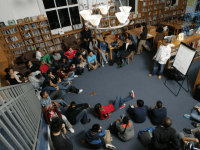Cracking the “Ice-Breaker Project” Jinx
Through teaching their classmates, reflecting on the experience, and refining their presentations, students learn how to create authentic, meaningful work.
I'm lousy at creating first projects. I overthink everything, and as a result they all take longer than I want and rarely come to a meaningful conclusion. I once asked a ninth grade student what I should do instead, and he suggested assigning a small task that will make students feel successful -- and that will end before boredom or confusion sets in.
Students Teaching Students
This year, I'm not teaching a project-based class, but I'm certainly incorporating elements of PBL into my classroom. I want to make sure that my students practice inquiry, collaboration, peer critique, and reflection, and that they'll always create with an authentic audience, purpose, and legacy in mind. Thus, I felt it was important to begin with a small project that wouldn't last more than a week, and would serve the following purposes:
- The students would be able to introduce themselves and ease into learning how to talk to each other in an "academic" way.
- It would get them thinking about presentation skills and the value of multiple drafts, and help them practice giving and receiving feedback and creating rubrics, as well as self-evaluation and reflection.
- Most importantly, it would start them thinking about how they learn best.
I struggled with this, always coming up with ideas that seemed far too complex or simplistic, but I was eventually nudged in the direction of having the kids practice teaching a short lesson. In this case, I decided that the students would present a two-minute lesson to their peers on a skill they knew well, or something that they loved and felt they could speak confidently about. This would begin as a quick, off-the-cuff exercise and would develop into a full-fledged, "professional" lesson, ready for the internet.
While every student had to teach, they taught in rounds -- they were divided into three groups and expected to teach the same lesson multiple times, each time to a new audience. For instance, each member of group A had to stand in a different part of the room, and teach to members of groups B and C for two minutes. Then the presenter would receive a new batch of Bs and Cs, and so on until every B and C had heard every member of A teach. At that point, it was the Bs turn to teach the As and Cs, and then the Cs taught. Each presenter thus taught the same lesson three or four times.
The subjects included minimizing anxiety by using pressure points, doing yoga poses, drawing cartoons, and even making rice or cooking an egg sunny side up. I had fun watching them have fun teaching, and I could hear some of the more transferable skills being practiced out in the hallway after class had ended.
In the following debrief, we discussed how it felt to teach for the first time, and what changed for them after multiple iterations. We also discussed what made an effective presentation -- from enunciation and cadence to conveying enthusiasm and love for the subject.
Rubrics and Presentations
The real challenge came next: turning that two-minute speech into a full multi-media presentation for a larger audience. The students went home that night to set up blogs, writing reflections in which they discussed what they had learned about teaching and how they'd change their presentations accordingly.
That allowed us to create a rubric to guide their video production after sampling some of the many how-to videos on YouTube. The students collectively decided that any presentation should:
- Appeal to the viewer
- Be useful by teaching something that can be immediately performed
- Be accurate in terms of its information
- Look as though genuine effort went into making it
I tasked the students with creating a rough draft of this video lesson, using the rubric to guide them. This was the version they posted to their blogs. The next day, we discussed some general parameters for peer feedback, after engaging with some of Ron Berger's writing on the importance of critique. We established ground rules for critique, and then moved immediately into feedback circles to review those first drafts using the rubric. These rules were:
- To be mindful of being supportive, yet constructive
- To be specific where possible
The students then used that experience to revisit and refine their initial presentations, and to post those final versions to their blogs. After this, I asked them, rather than providing more peer critique, to evaluate themselves -- to consider how successful they had been at driving viewer interest, providing useful examples and commentary, putting forth their best effort, etc.
The Students Reflect
The final piece of the puzzle was for the students to write a reflective blog discussing what they felt they'd learned over the course of the five-day project. I include some samples below.
While there's always room for tinkering, the students did get a good hands-on learning experience that was tied to something they loved, which allowed me to introduce some of the foundational skills for the class in a natural way. I finally feel as if I've broken the opening project jinx.
